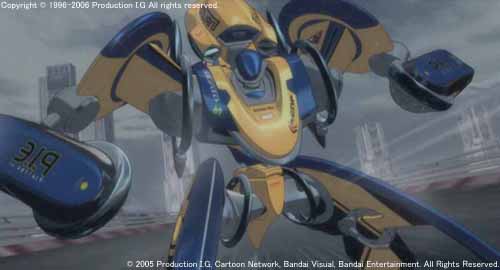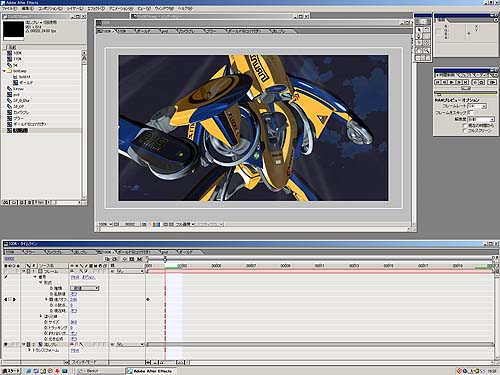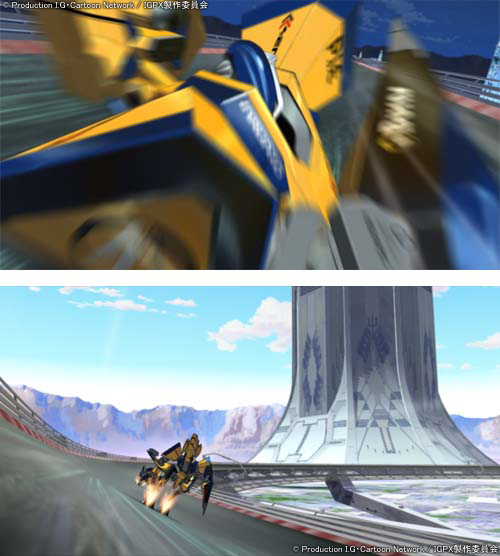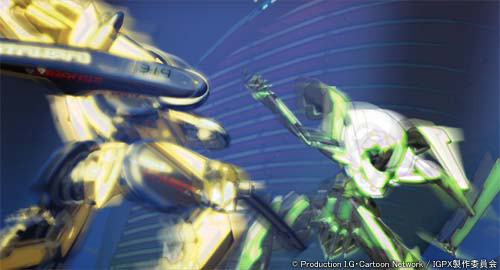The Making of IGPX 3D Animation Step 5: Compositing

Hyper-dynamic battles between lavishly detailed IG machines running at speed higher than 400 km/h is definitely one of IGPX most impressive characteristics.
For this reason, we decided to get inside Production I.G's 3D Room, and ask the computer graphics team to tell us everything about the creative process behind the astounding mechs of IGPX.
STAFF PROFILE
Miki Yoshida
3DCGI. Yoshida is the leader of the IGPX 3D animation team. His main works include: Blood: The Last Vampire (2000), Kaidohmaru (2001) and Ghost in the Shell: Stand Alone Complex (2002).

What is the process called compositing?
Yoshida: After all of the processes that I've been explaining are complete, we have this process of compiling everything into one; in other words, compositing everything all at once. This process is done the same way as the previous ones. Each one of us, who is responsible for specific scenes, takes it up to the end of this compositing process. After this is finished, we will hand it over to the internal check.
Even in this stage of compositing, we see each one's individual styles materialize. I see extra work done (and sometimes not done) in some places to make the scenes look better. That might be due to each one's taste. This is especially noticeable in the visual effects; for example, wavering, which we call "blur", putting an afterimage to things moving sideways, under- or overexposing the sparks that had just come out of machines, or the size of the pin spot. These are the instances in which you can see great differences between individuals. You can even see the difference between the vertical and horizontal swaying of the screen. That said, it's actually hard to detect them since they are so minute.
On top of compositing the materials, effects that are captured in 2D with After Effect - i.e. processing high contrast and adjusting the blurring - are done at this stage. Although I said, "compositing," it feels more or less like doing the effects. The main work would include adding "air-ness" to the scene. For instance, we put pale blue-green splashes on the background of buildings or long racing tracks at the back to fade the 3D effect, so that the 3D effect of the objects in the foreground will stand out to make the scene look more real. If everything in a scene looks too clear - for example, carrying too much data - then viewers will be overwhelmed and feel exhausted. That's not an efficient way of showing what you'd like the viewers to see. So we have a protocol to add an "air-ness" effect and adjust the entire scene.
In these procedures, we are asking Kanta Kamei, who does special shots for each scene, to look at them or tell us how he shoots. In other words, he is teaching us hands-on techniques as we progress. We learn a lot by watching other people at work.

I see. It's not just gathering and compositing all the materials from the previous process.
Yoshida: Yeah. It's a finishing process, if you'd like to put it that way, so we put a lot of energy into it. To tell you the truth, when we look at episodes 1 and 2, some buildings are oddly too dark. That's because we didn't apply "air-ness" to them. Basically, the buildings look brighter under light, but they are totally black where there is no light. When we add "air-ness," it looks more like it's under the natural light and the building immediately looks brighter by one magnitude. Although the background paraphernalia still stay as data, they are toned down. As a result the entire scene looks more harmonized.
In the beginning, the basic protocol did not exist, so the background buildings were completely dark and looked too clear to the eyes. (laughs) If you ever have a chance to see them and compare, you'd understand what I mean.
Do you add the blurring or trembling effects as if the scene was shot with a handy cam at this compositing stage?
Yoshida: Everything. And in Episode 13, where Cunningham's machine goes out of control and Takeshi goes into a fight in the speed mode, we added more touches by compositing, for instance, by adjusting colors. In the 3D scenes, we started from scratch and eventually changed the coloring, applied staggered timing and added strong blur in the compositing phase. We've done a lot of things. The compositing process is really fun since we have so many options and it's up to us to come up with a spectacular scene.
We had one part where we had rendered the motion to perfection, and then, after the compositing process, the motion was lost. We didn't foresee this, so we always did 200% in every process. But now, we take into account the upcoming compositing process when we work on motions. I could say we work with a better perspective. This way we are more efficient and the result is more effective.
Before, when 3D process didn't cover the entire process, I'd make a 3D model, then render the motion and ask someone else to complete the scene. I was very curious how the 3D's turned out. Now we have the entire process under our control, and we are gaining more skills to work in that environment. I am very grateful for this opportunity.

© 2005 Production I.G, Cartoon Network, Bandai Visual, Bandai Entertainment. All Rights Reserved.

![WORK LIST[DETAILS]](/contents/works/design/images/left_title.gif)



 terms of use
terms of use